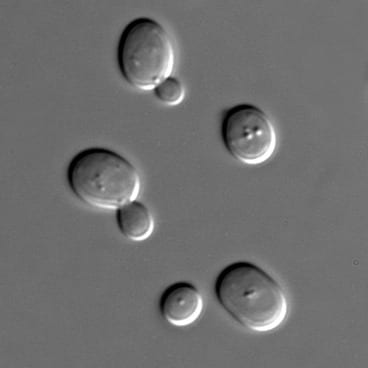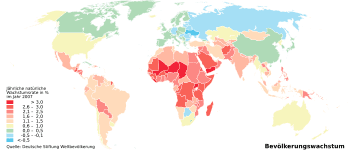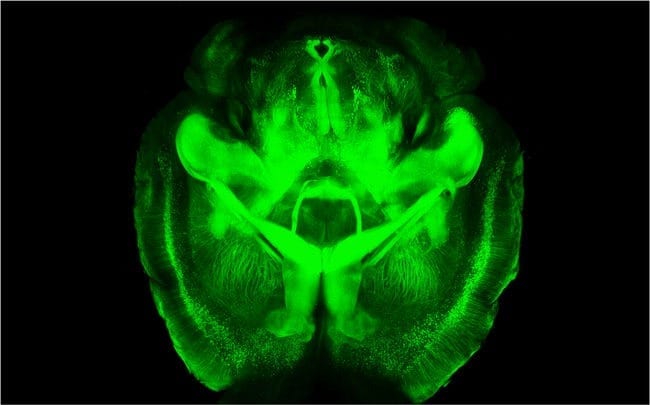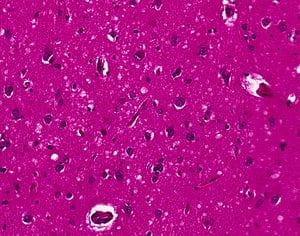
Spatial measurements of population density could reveal when threatened natural populations are in danger of crashing.
Many factors — including climate change, overfishing or loss of food supply — can push a wild animal population to the brink of collapse. Ecologists have long sought ways to measure the risk of such a collapse, which could help wildlife and fishery managers take steps to protect endangered populations.
Last year, MIT physicists demonstrated that they could measure a population’s risk of collapse by monitoring how fast it recovers from small disturbances, such as a food shortage or overcrowding. However, this strategy would likely require many years of data collection — by which time it could be too late to save the population.
In a paper appearing in the April 10 online edition of Nature, the same research team describes a new way to predict the risk of collapse, based on variations in population density in neighboring regions. Such information is easier to obtain than data on population fluctuations over time, making it potentially more useful, according to the researchers.
“Spatial data are more accessible,” says Lei Dai, an MIT graduate student in physics and lead author of the study. “You can get them by satellite images, or you could just go out and do a survey.”
Led by Jeff Gore, an assistant professor of physics, Dai and Kirill Korolev, a Pappalardo Postdoctoral Fellow, grew yeast in test tubes and tracked the populations as they approached collapse. Yeast cells cooperate with other members of the population: Each of the organisms secretes an enzyme that breaks down sucrose in the environment into smaller sugars that it can use as a food source. All of the yeast benefit from this process, so a population is most successful when it maintains a certain density — neither too low nor too high.
In last year’s study, the researchers found that in populations of yeast that are subjected to increasingly stressful conditions, populations become less and less resilient to new disturbances until they reach a tipping point at which any small disruption could wipe out a population.
This phenomenon can be spotted quickly in yeast, which produces about 10 new generations per day, but measuring these population fluctuations for species such as fish or deer would take much more time. In hopes of finding more useful signals, the researchers turned their attention to spatial information.
There goes the neighborhood
In their new study, the researchers theorized a new type of indicator that they call “recovery length” — the spatial counterpart to recovery time. This idea is based on the observation that populations living near the boundary of a less hospitable habitat are affected, because the neighboring habitats are connected by migration. Populations further away from the bad region gradually recover to equilibrium, and the spatial scale of this recovery can reveal a population’s susceptibility to collapse, according to the researchers.
To test this idea, the researchers first established several linked yeast populations in a state of equilibrium. At the end of each day, a certain percentage of each population was transferred to adjacent test tubes, representing migration to adjacent regions.
The researchers then introduced a “bad” habitat, where only one in every 2,500 yeast survives from one day to the next. This reduction in population mimics what might happen in a natural population plagued by overfishing, or by a drastic reduction in its food supply.
The MIT team found that populations closest to the bad habitat had the hardest time maintaining an equilibrium state. Populations farther away maintained their equilibrium more easily.
“There’s some distance you have to go away from the bad region in order to get recovery of the population density,” Gore says. “How far you have to go before you reach equilibrium is the recovery length, and that tells you how close these populations are to collapse.”
The recovery length varies based on how much stress the populations are already under.
To apply this finding to a natural population, population density would need to be measured in a range of adjacent areas at increasing distances from a good/bad boundary. This information could then be mapped to reveal the recovery length. “What’s great about the recovery length is you don’t need a long time series. You could just measure it at one moment in time,” Gore says.
“It is exciting to see how different groups around the world are now pushing the research on generic early-warning signals forward in such innovative ways,” says Marten Scheffer, a professor of aquatic ecology and water quality management at Wageningen University in the Netherlands, who was not part of the research team. “This result will inspire field ecologists to have a fresh look at the patterns they study, to see if they may tease out critical information about fragility of different populations of threatened species.”
The Latest Bing News on:
Warning signs of population collapse
- Tornadoes Collapse Buildings and Level Homes in the USon April 27, 2024 at 4:13 am
Tornadoes wreaked havoc Friday in the US Midwest, causing a building to collapse with dozens of people inside and destroying and damaging hundreds of homes, many around Omaha, Nebraska. As of Friday ...
- Armenian community commemorates 109th anniversary of Armenian Genocide by bringing awareness to refugee crisison April 27, 2024 at 3:30 am
Racine’s Armenian community, who just commemorated the Armenian Genocide’s 109th anniversary on April 24, is hosting a talk featuring Winslow Martin, who photographed and documented the Armenian refug ...
- Reedsburg man accused of killing pregnant girlfriend, dumping her body in Chippewa County enters not guilty pleaon April 26, 2024 at 6:46 am
Man accused of killing pregnant girlfriend enters not guilty pleas in Chippewa County Court. Body found in suitcase in Town of Wheaton.
- A GDP Warning as Signs of Stagflation Appearon April 25, 2024 at 2:43 pm
Slower growth and persistent inflation explain why voters feel glum about the economy.
- Recovery of ozone layer shows how to protect the planeton April 24, 2024 at 2:12 pm
There was a time, not so long ago, when the depletion of Earth’s ozone layer seemed like an insurmountable challenge. Decades of using harmful chemicals, such ...
- Drivers counted the number of dead bugs on their number plate for studyon April 23, 2024 at 5:17 pm
The Bugs Matter survey is based on the windscreen phenomenon - anecdotal evidence from drivers that they collect fewer insects on their windscreens now.
- Only 700 Americans are studying in China. Will the US lose a generation of experts?on April 23, 2024 at 2:11 pm
China travel have put would-be American study-abroad students in a tight spot – and risk robbing the U.S. of its next generation of China experts.
- Salt Lake City experience coming-of-age momenton April 20, 2024 at 12:02 pm
It may look like an NHL team has just fallen into Salt Lake City's lap. But local organizers say the Arizona Coyotes' relocation to Utah is the product of a yearslong effort to beckon professional ...
- Reuters photographer wins World Press Photo of the Year with poignant shot from Gazaon April 18, 2024 at 11:07 am
Reuters photographer Mohammed Salem captured this year’s prestigious World Press Photo of the Year award Thursday with his heartrending image of a Palestinian woman cradling the body of her young ...
- Top diplomats meet to mobilize aid for Sudan, wrecked by war and on the brink of famineon April 15, 2024 at 2:00 am
The U.N. humanitarian campaign needs some $2.7 billion this year to get food, health care and other supplies to 24 million people in Sudan.
The Latest Google Headlines on:
Warning signs of population collapse
[google_news title=”” keyword=”warning signs of population collapse” num_posts=”10″ blurb_length=”0″ show_thumb=”left”] [/vc_column_text]The Latest Bing News on:
Population collapse
- UK officials decline to comment on reports that British troops may be asked with delivering Gaza aidon April 27, 2024 at 12:16 pm
The BBC is reporting that British troops may be tasked with delivering aid to Gaza from an offshore pier now under construction by the U.S. military ...
- US birth rate falls to record low amid global declineon April 27, 2024 at 9:43 am
The US birth rate fell to a record low last year amid a global decline in the number of people having children.
- In Japan, regional revitalization fails to halt population declineon April 26, 2024 at 11:21 pm
Efforts to revitalize rural areas through various incentives has yielded limited results as people continue to gravitate toward urban centers.
- Gateway Markets Are Losing Population Despite Immigration Influxon April 26, 2024 at 1:09 pm
Gateway markets are losing populations, but immigration is boosting the potential resident base in key destinations such as California, Texas, and Florida.
- Colin McNickle: The vicious cycle of Greater Pittsburgh’s population losson April 26, 2024 at 8:00 am
Pittsburgh cannot thrive without a growing population, concludes an analysis by the Allegheny Institute for Public Policy. “As population falls, so does the number of people available for the labor ...
- Population Map Reveals States Growing, Shrinking the Quickeston April 25, 2024 at 11:56 am
In fact, Texas was not the only fast-growing state in the country. Kaufman County, outside of Dallas, was the "fastest growing county in the entire U.S.," Poston said. The county saw a population ...
- Why Baltimore is facing a decline in populationon April 25, 2024 at 1:23 am
"Almost a million people were living in Baltimore City," Summers said. "Today, the population is hovering around 570,000, yet there seems to be no alarm bells going off in city hall." He believes that ...
- Bee population decline: Reach for the phone and not the pesticideon April 21, 2024 at 7:13 pm
There’s been a steady decline in the honeybee population in this country and entire colonies are lost this time of year due to people mistaking the swarm bees themselves as a threat.
- Assessing population decline and its implicationson April 21, 2024 at 5:00 pm
As the world grapples with the spectre of population collapse, Jamaica finds itself at a crossroads, facing a looming demographic crisis that threatens its social, economic, and cultural fabric.
- America is uniquely ill-suited to handle a falling populationon April 18, 2024 at 5:56 am
Between 2010 and 2020 over half of the country’s counties, home to a quarter of Americans, lost population (see map). Over the coming decades still more will, because America’s population is growing ...
The Latest Google Headlines on:
Population collapse
[google_news title=”” keyword=”population collapse” num_posts=”10″ blurb_length=”0″ show_thumb=”left”]










